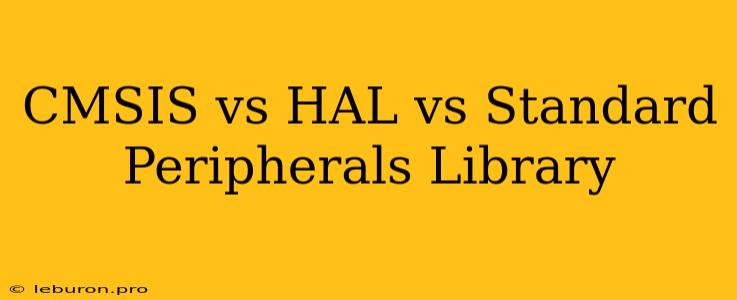The world of embedded systems development is filled with numerous libraries and frameworks designed to simplify the process of interacting with hardware components. Among these, the CMSIS, HAL, and Standard Peripherals Library stand out as popular choices, each offering a distinct approach to interacting with microcontrollers. Choosing the right library depends on your specific project requirements and development preferences. This article delves into the intricacies of each library, exploring their functionalities, advantages, and disadvantages, enabling you to make an informed decision for your next embedded system project.
Understanding the Core: CMSIS, HAL, and Standard Peripherals Library
The CMSIS (Cortex Microcontroller Software Interface Standard) serves as a foundational layer, providing a standardized interface between software and hardware components. It defines a set of common APIs and data structures that enable portability across different microcontroller architectures. This standardization simplifies development by ensuring that the same code can be reused across diverse platforms.
The HAL (Hardware Abstraction Layer) builds upon CMSIS, offering a higher-level abstraction for controlling hardware peripherals. It encapsulates the complexities of low-level device registers, presenting a user-friendly interface for interacting with peripherals like timers, GPIO pins, and communication interfaces. HAL libraries are typically vendor-specific, meaning they are tailored to a particular microcontroller family or vendor.
The Standard Peripherals Library (SPL) provides a comprehensive set of functions and macros that allow direct access to the microcontroller's peripherals. It operates at a lower level compared to HAL, granting developers more control over hardware configuration and operation. However, this increased control also comes with the responsibility of managing low-level details, potentially increasing development complexity.
A Comparative Analysis: Choosing the Right Library
To effectively choose the right library for your embedded system project, it's crucial to understand the strengths and weaknesses of each option.
CMSIS: The Foundation
Advantages:
- Portability: CMSIS promotes code reusability across different microcontroller families, reducing development time and effort.
- Standard Interface: Provides a standardized framework for interacting with hardware, enhancing code consistency and maintainability.
- Simplified Hardware Access: Simplifies access to hardware components by defining common data structures and APIs.
Disadvantages:
- Limited Functionality: Primarily focuses on providing a standard interface, offering minimal functionality for direct peripheral control.
- Vendor Dependency: Requires vendor-specific drivers for specific hardware peripherals.
HAL: Abstraction for Convenience
Advantages:
- User-Friendly Interface: Simplifies peripheral control with a higher-level abstraction, reducing development effort.
- Vendor-Specific Optimization: Designed to be optimized for specific microcontroller families, potentially leading to better performance.
- Abstraction of Low-Level Details: Hides low-level hardware complexities, allowing developers to focus on higher-level application logic.
Disadvantages:
- Performance Overhead: The abstraction layer can introduce some performance overhead due to the added layers of indirection.
- Less Flexibility: May limit the ability to fine-tune hardware configurations compared to the Standard Peripherals Library.
Standard Peripherals Library: Direct Control
Advantages:
- Direct Hardware Access: Provides direct access to hardware registers, offering granular control over peripheral behavior.
- Performance Optimization: Can achieve optimal performance by directly manipulating registers, reducing potential overhead.
- Maximum Flexibility: Enables fine-tuning of hardware configurations for specific applications.
Disadvantages:
- Complexity: Requires a deeper understanding of microcontroller architecture and hardware specifics.
- Portability Issues: Code written for one microcontroller family may not be directly portable to another.
- Increased Development Time: Requires more time to manage low-level details and configure hardware peripherals.
Choosing the Right Fit for Your Project
The decision to choose between CMSIS, HAL, or Standard Peripherals Library depends on several factors:
- Project Complexity: For complex projects with multiple hardware peripherals, HAL or Standard Peripherals Library can simplify development.
- Performance Requirements: If performance is paramount, the Standard Peripherals Library offers direct hardware access for optimization.
- Code Reusability: Prioritizing code portability across different microcontroller families favors CMSIS and HAL.
- Development Experience: Developers with extensive experience in microcontroller programming may find the Standard Peripherals Library more suitable.
- Vendor Support: The availability of HAL libraries and documentation from the microcontroller vendor can be a deciding factor.
In conclusion, the CMSIS provides a foundational layer, HAL offers a higher-level abstraction, and Standard Peripherals Library grants direct hardware control. Each library serves a different purpose, and the ideal choice ultimately depends on the specific requirements and priorities of your embedded system project. By understanding the nuances of each library, you can select the best tool for your development journey, simplifying complex hardware interactions and achieving optimal results for your embedded system applications.
